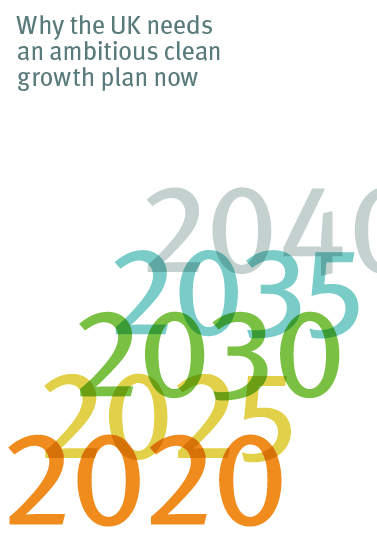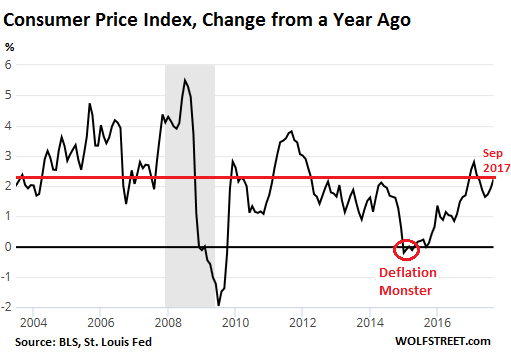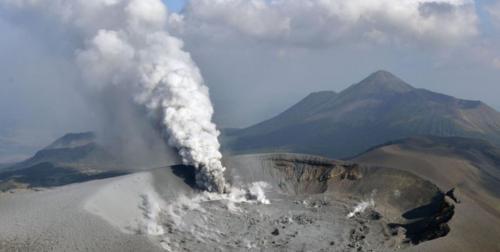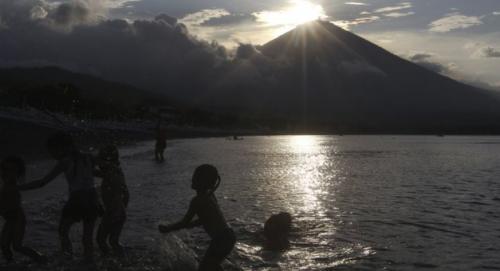Steve Bull's Blog, page 1286
October 14, 2017
Wave Of Eruptions Along Pacific ‘Ring Of Fire’ Leave 10,000s Displaced
The Pacific “Ring of Fire” is living up to its name.
The 450 or so volcanoes that make up the ring outline have been unusually active this year, sparking evacuations on the Indonesian island of Bali and on the tiny island nation of Vanuatu. Parts of southwestern Japan, meanwhile, have been shaken by a series of earthquakes, unsettling the local population, in an area where the massive Pacific Plate grinds against other plates that form the Earth’s crust, creating a 25,000-mile zone where earthquakes and volcanic eruptions are unusually common.
Three volcanos have either erupted, or are showing signs of an imminent eruption, across the region, according to a roundup published by the Associated Press.
Japan:
The Shinmoedake volcano in southwestern Japan started erupting Wednesday for the first time in about six years. An ash plume rose 1,700 meters (5,580 feet) from the crater Thursday and ash fell on cities and towns in Miyazaki prefecture. Japanese broadcaster TBS showed students wearing helmets and masks on their way to school at the foot of Shinmoedake. The Japan Meteorological Agency is warning that hot ash and gas clouds known as pyroclastic flows could reach 2 kilometers (1 mile) from the crater, and ash and volcanic rocks are a risk over a wider area depending on wind and elevation. It raised the volcanic alert level from 2 to 3 on a scale of 5. Level 3 warns people to not approach the volcano.
Bali:
More than 140,000 people fled Mount Agung on the Indonesian resort island of Bali after its alert status was raised to the highest level on Sept. 22.
…click on the above link to read the rest of the article…
Puerto Rico Without Electricity, Wifi, ATMs Shows Importance of Cash, Gold and Silver
– Puerto Rico without electricity, wifi, ATMs shows importance of cash, gold and silver
– Most of Puerto Rico remains in the dark and without power three weeks after storm
– With widespread power failures, Puerto Rico remains cash only with retailers only accepting cash and few consumer having cash
– Shortages of food, fuel and medicine with infrastructure repairs delayed
– Power could be ‘out for months’ as 85% of people remain off the grid
– Around 75% of ATMs disconnected
– Electronic forms of payment including bitcoin have been rendered non viable
– Puerto Rico’s accidental ‘cashless society’ shows risks of cashless society and importance of holding cash, gold and silver out of the financial and digital systems
 Aerial photo of flooding in Puerto Rico. Washington Post
Aerial photo of flooding in Puerto Rico. Washington Post
Puerto Rico has been destroyed by two savage hurricanes which have plunged the island into darkness and despair. The landscape of ruined homes and entire towns resembles Hiroshima after the man made disaster of a nuclear bomb being dropped on the city.
More than three weeks since Hurricane Maria hit the island, 3.7 million American citizens are on the precipice of a humanitarian disaster. The majority of these people are desperate for food, water, electricity and shelter. They are desperate for cash that will allow them to secure these basic necessities.
Over 84% of the island remains without power and 37% of people are without access to water. Without power, much of the population is does not have electricity to charge their phones and iphones. Very few have wifi and this is severely impacting their ability to communicate and conduct their lives.
Inevitably, the future of Puerto Rico now lies in the wrangling hands of government and financial organisations, all of which seem to be pointing the finger of blame at one another.
…click on the above link to read the rest of the article…
Is North Korea On “Death Ground” With No Recourse But To Fight Or Die?

Fox News reported this on October 11, 2017, in the article North Korea says Trump ‘Lit the Wick of War,’ vows a hail of fire:
“ On Wednesday, the U.S. and South Korea flew two strategic bombers over the Korean peninsula in a joint military exercise — another show of force against Pyongyang amid the mounting tensions. The bombers also conducted firing exercises over the East Sea and Yellow Sea, according to the BBC . Japan’s air force also joined the drill. This is the second time since Trump’s fiery U.N. General Assembly speech that North Korea vocally accused the U.S. of declaring war on its country. Trump lambasted “little rocket man” Kim Jong Un for going on a “suicide mission for himself and his regime” in the speech last month. He vowed to “totally destroy” the country if it did not halt its nuclear program.”
Additionally, this information was released in the article North Korea Hackers Reportedly Stole US, South Korea War Plans, by Fox News on October 10, 2017:
“A plan to assassinate Kim Jong Un and preparations for a potential nuclear showdown with North Korea were among the trove of South Korean military documents reportedly stolen by Hermit Kingdom hackers. South Korea’s Defense Ministry did not comment on the alleged hack, which reportedly occurred in September 2016 but was only revealed Tuesday. Rhee Cheol-hee, a lawmaker in South Korea, confirmed the data breach to the BBC. The hack consisted of 235 gigabytes of military documents and about 80 percent of what was stolen hasn’t been identified.
…click on the above link to read the rest of the article…
US Quietly Bolsters Forces in Poland Breaching Russia-NATO Deal
The US took advantage of the ballyhoo raised over the “Russian threat” allegedly posed by joint Russian-Belarusian Zapad-2017 military exercise held in September to increase its Army presence in Poland. The alliance again tried to reaffirm its bogus Russia narrative but the Zapad training event was transparent with observers invited and the forces withdrawn to home bases after it was over.
According to Russian Defense Ministry spokesman Igor Konashenkov, the US 3rd Armored Brigade Combat Team, 4th Infantry Division, was meant to have rotated out of Europe with its weapons and equipment left to be manned by troops of the US 2nd Armored Brigade Combat Team, 1st Infantry Division. Instead, the 2nd Armored Brigade had been quietly deployed to Poland (Boleslawiec, Drawsko Pomorskie, Torun, Skwierzyna, Zagan) with its own armored vehicles, while weaponry and equipment of the 3rd Brigade had remained and could be manned within 2 hours by bringing in troops from the US Ramstein Base in Germany. An armored brigade combat team comprises about 4,200 troops and includes approximately 250 tanks, Bradley Fighting Vehicles and Paladin self-propelled howitzers, plus 1,750 wheeled vehicles.
The move was taken against certain background. NATO has already deployed four multinational battalions across Poland, Lithuania, Latvia and Estonia. In a separate move, the US military sent the 2nd Armored Brigade Combat Team along with a corresponding aviation brigade, to Gdansk on a year-round basis in September. It was the first time two armored brigades with full complement of soldiers and equipment were deployed in Europe under the pretext of supporting the exercise dubbed Operation Atlantic Resolve.
…click on the above link to read the rest of the article…
Neoliberalism Was Never about Free Markets
From the beginning, it was about watering down classical liberalism.
One of the most accusatory and negative words currently in use in various politically “progressive” circles is that of “neoliberalism.” To be called a “neoliberal” is to stand condemned of being against “the poor,” an apologist for the “the rich” and a proponent of economic policies leading to greater income inequality.
The term is also used to condemn all those who consider the market economy to be the central institution of human society as being against “community,” shared caring, and concern for anything beyond supply and demand. A neoliberal, say critics, is one who reduces everything to market-based dollars and cents and disregards the “humane” side of mankind.
The opponents of neoliberalism, so defined, claim that its proponents are rabid, “extremist” advocates of laissez-faire, that is, a market economy unrestrained by government regulations or redistributive fiscal policies. It calls for the return of the worst features of the “bad old days” before socialism and the interventionist-welfare state attempted to abolish or rein in unbridled “anti-social” capitalism.
The Birth of Neoliberalism: Walter Lippmann and a Paris Conference
He warned of the complementary danger from “creeping collectivism” in the form of the regulatory and interventionist policies.
The historical fact is that these descriptions have little or nothing to do with the origin of neoliberalism, or what it meant to those who formulated it and its policy agenda. It all dates from about eighty years ago, with the publication in 1937 of a book by the American journalist and author, Walter Lippmann (1889-1974), entitled, An Inquiry into the Principles of the Good Society, and an international conference held in Paris, France in August of 1938 organized by the French philosopher and classical liberal economist, Louis Rougier, centered around the themes in Lippmann’s book. A transcript of the conference proceedings was published later in 1938 (in French) under the title, Colloquium Walter Lippmann.
…click on the above link to read the rest of the article…
Blowout Week 198
 This week we feature the UK’s just-published Clean Growth Strategy, which finally gives the UK a defined energy policy. Or does it? One of the two follow-up articles describes it as “next to worthless”. We continue with our usual mix of energy-related stories, including oil in Brazil; China’s shale oil reserves; Russia buys into Mediterranean gas; Olkiluoto nuclear plant delayed again; Hinkley Point and nuclear weapons; Trump to terminate Obama’s clean energy plan; Norway trims EV subsidies; Netherlands, Canada and UK lead the coal phaseout; the California Duck Curve; a wind turbine in Ontario; a Megabattery in Sheffield; a rotating solar house in Spain and how wind could power all of human civilization.
This week we feature the UK’s just-published Clean Growth Strategy, which finally gives the UK a defined energy policy. Or does it? One of the two follow-up articles describes it as “next to worthless”. We continue with our usual mix of energy-related stories, including oil in Brazil; China’s shale oil reserves; Russia buys into Mediterranean gas; Olkiluoto nuclear plant delayed again; Hinkley Point and nuclear weapons; Trump to terminate Obama’s clean energy plan; Norway trims EV subsidies; Netherlands, Canada and UK lead the coal phaseout; the California Duck Curve; a wind turbine in Ontario; a Megabattery in Sheffield; a rotating solar house in Spain and how wind could power all of human civilization.
Energy Live News: UK Government unveils Clean Growth Strategy
The UK Government has set out its Clean Growth Strategy to boost national income and output whilst simultaneously cutting greenhouse gas emissions.
An investment of £2.5 billion will support low carbon innovation from 2015 to 2021, as part of the largest increase in public spending on science, research and innovation in more than three decades. The Green Finance Taskforce will provide up to £20 million to support a new early stage investment fund for clean technologies. The UK will also spend £3.6 billion to upgrade around a million homes through the Energy Company Obligation (ECO) and extend the scheme until 2028. The Clean Growth Strategy heralds the end of an era for conventional petrol and diesel vehicles and coal generation, which will be phased out by 2040 and 2025 respectively. The government plans to spend £1 billion supporting the take-up of ultra low emission vehicles (ULEV) and around £900 million in smart, nuclear and renewable technologies to fill this gap. It also says targeting a total carbon price in the power sector will give businesses greater clarity on the total price they must pay for each tonne of emissions.
…click on the above link to read the rest of the article…
October 13, 2017
Oil Prices Spike On Middle East Tensions

Oil prices rose on Friday on bullish data from China showing an uptick in oil imports by 1 million barrels per day in September, from a month earlier. On top of that, anxiety over President Trump’s decision to decertify the Iran nuclear deal, plus simmering tension in Iraq likely added a bit of upward pressure on crude prices. WTI and Brent gained more than 2 percent in early trading on Friday.
(Click to enlarge)
(Click to enlarge)
(Click to enlarge)
(Click to enlarge)
(Click to enlarge)
(Click to enlarge)
(Click to enlarge)
(Click to enlarge)
Friday, October 13th, 2017
Trump to decertify Iran deal. President Trump has confirmed his plan to decertify the Iran nuclear deal on Friday, a move that could ratchet up tensions between the two nations. However, he will stop short of calling for new sanctions. Instead, he will ask the U.S. Congress to hold off until the administration tries a new strategy to tighten the screws on Tehran. Iran promised a “crushing” response if the U.S. declared the Revolutionary Guard a terrorist organization. As of now, the ramifications for the oil market are unclear, but probably not that significant in the near-term. The key European nations party to the agreement are still supporting the original deal.
Troops mobilize in Iraq. Kurdish authorities have sent thousands of troops to the key oil region of Kirkuk to defend the region, after the Iraqi government mobilized troops and tanks south of the city. The military movements raised concerns of a possible clash between the central government in Baghdad and Kurdish forces, a development that some fear could lead to civil war. Related: Kurdistan Accuses Baghdad Of Planning Oil Field Seizure
…click on the above link to read the rest of the article…
Too Good For Too Long

Shutterstock
Too Good For Too Long
Over-extended systems contract quickly & violently
I’m writing this from my home in Sonoma County at the end of an intense week of witnessing firsthand the devastation caused by the many current fires burning in northern California. While it’s hard to focus on anything other than the moment-to-moment developments of this still-unfolding disaster (which I’ve been chronicling here), it’s already clear that the implications for my part of the state will last for many, many years to come.
It’s amazing how instantly the status quo where I live has changed. The world my neighbors and I lived in when we all went to bed on Sunday night simply no longer existed by the time we woke up on Monday morning. Lives have been lost. Entire neighborhoods — thousands of homes — have burned to the ground. Businesses, hospitals and schools are now shuttered.
Having now experienced this personally — on top of watching news reports over the previous weeks of similarly abrupt “before/after” transitions in Houston, Florida, Puerto Rico, Mexico City, Las Vegas and Catalonia — I have a new-found appreciation for the maxim that when it arrives, change happens quickly — usually much more quickly than folks ever imagined, catching the general public off-guard and unprepared.
We humans tend to think linearly and comparatively. In other words, we usually assume the near future will look a lot like the recent past. And it does much of the time.
But other times it doesn’t. And that’s where the danger lies.
The Cruel Math
In 1987 a Danish physicist named Per Bak released a landmark paper introducing the concept of self-organized criticality. Bak observed that complex systems draw stability through an ongoing cycle of corrective collapses that keep the overall system from becoming too over-extended.
…click on the above link to read the rest of the article…
Yellen Was Right: “Transitory” Factors of “Low” Inflation Are Reversing, with Much More to Come
What’s Boiling Beneath the Surging Inflation?
Consumers are going to shell out more money for the same stuff, that’s for sure. Inflation as measured by the Consumer Price Index jumped 2.2% in September compared to a year ago, the Bureau of Labor Statistics reported this morning. All fingers pointed at energy costs: the index jumped 10.1% year-over-year. Within it, “motor fuel” prices (gasoline and diesel) jumped 19.2%.
Food prices rose 1.2% year-over-year, kept down by prices for “food at home” – the stuff you buy at the grocery store – which inched up only 0.4% year-over-year in part due to the price war currently tearing into the supermarket sector.
In the chart below of CPI, note the dreadful “Deflation Monster” – one of those rare and brief occasions in the US when the purchasing power of wages actually rose just a tiny bit on a year-over-year basis. It was caused by the energy bust. And it was “transitory”:

In the chart, note how CPI jumped 2.8% in February and then retreated through June. This retreat was brushed off as “transitory” by Fed Chair Janet Yellen and other Fed governors when they vowed to continue raising rates. She had specifically pointed out a few of those “transitory” factors. And they’re now turning around.
One of these factors that Yellen had pointed out was telephone services, which includes the monthly costs that consumers pay for their smartphones. Those costs plunged as a price war among wireless carriers had broken out in 2016. This summer, the price index for telephone services was down around 9% year-over-year. The wireless component plunged as much as 13%. But that consumer bonanza could not last.
…click on the above link to read the rest of the article…
Prepare for a Chinese Maxi-devaluation

Prepare for a Chinese Maxi-devaluation
China is a relatively open economy; therefore it is subject to the impossible trinity. China has also been attempting to do the impossible in recent years with predictable results.
Beginning in 2008 China pegged its exchange rate to the U.S. dollar. China also had an open capital account to allow the free exchange of yuan for dollars, and China preferred an independent monetary policy.
The problem is that the Impossible Trinity says you can’t have all three. This model has been validated several times since 2008 as China has stumbled through a series of currency and monetary reversals.
For example, China’s attempted the impossible beginning in 2008 with a peg to the dollar around 6.80. This ended abruptly in June 2010 when China broke the currency peg and allowed it to rise from 6.82 to 6.05 by January 2014 — a 10% appreciation.
This exchange rate revaluation was partly in response to bitter complaints by U.S. Treasury Secretary Geithner about China’s “currency manipulation” through an artificially low peg to the dollar in the 2008 – 2010 period.
After 2013, China reversed course and pursued a steady devaluation of the yuan from 6.05 in January 2014 to 6.95 by December 2016. At the end of 2016, the Chinese yuan was back where it was when the U.S. was screaming “currency manipulation.”
Only now there was a new figure to point the finger at China. The new American critic was no longer the quiet Tim Geithner, but the bombastic Donald Trump.
Trump had threatened to label China a currency manipulator throughout his campaign from June 2015 to Election Day on November 8, 2016. Once Trump was elected, China engaged in a policy of currency war appeasement.
China actually propped up its currency with a soft peg. The trading range was especially tight in the first half of 2017, right around 6.85.
…click on the above link to read the rest of the article…














